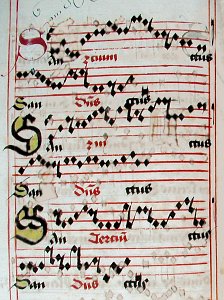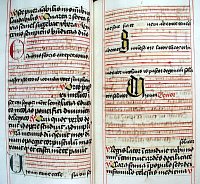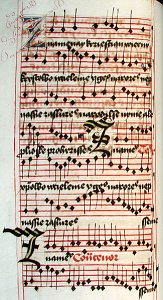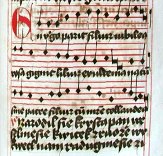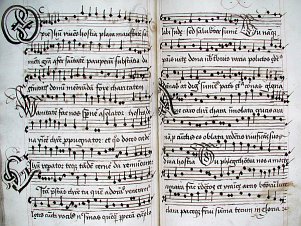
The Gradual of the Czech Museum of Silver in Kutna Hora
This source is stored in the depository of the Czech Museum of Silver in Kutna Hora under the signature of 88/85. In regard to of its musical importance, it is the most outstanding manuscript of the late Gothic from Kutná Hora. Covered in leather, it contains four hundred sheets of music, 210x315 mm in size. Many pages in the book, including the introductory pages, have been torn out. The book must have been subsequently re-bound, because as some of the pages are jumbled.
Document age:
The source does not contain any information about the order party, writer or the date of origin. Anyhow, by analyzing the content, ornamentation and the filigrees (watermarks denoting the paper-mill), the origins can be dated to the year 1500 [4, 7, 24]. Some compositions may have been added later.
From the musical point of view, it is especially outstanding because of its numerous polyphonic compositions. Besides the traditional repertoire of the liturgical year chorale compositions, it also includes a number of one-voice and two-voice strophic songs, both Latin and Czech. It also contains multi-textual medieval motets. Its repertoir is similar to other Graduals from the beginning of the 16th century (Franus, Codex Specialis, Chrudim,…), however it differs remarkably in its edition and occurrence of individual songs. It is interesting that this source has passed unnoticed to researchers up to the present time [24] [17] .
The Gradual is not very rich as the ornamentation is limited to multicolor initials and versal letters which were created probably by the scribe himself. It does not contain any illuminations. ‘Baroque hand’ notesinscribed on the edges make it evident that the Gradual was used for the following centuries [24]. Some of the compositions are incomplete and they lack the melody score in the staff, which helps us to see the process of Gradual making.
The content corresponds with the repertoire of the utraquist church. One example of of the evidences is for this is involves the instance the heading on the sheet 15b “Magistri Johannis Hus glorifi~” which was supposed to continue on the next page, but has been torn out.
Chorale part:
The content of the chorale part corresponds with other Graduals of that time. Very interesting is the citation of the Easter sequence Victime paschali laudes with the Christmas text on the fol. 388b. (This version can also be found in the songbook: Arnošt z Pardubic sequencionary dated 1363 [24]). Fol. 43b-47a contain 5 two and three-voice compositions of Sanctus (/Benedictus) in choral and mensural notation. Other parts of the mass have not been arranged into polyphony.
Strophic songs:
The Gradual contains many one, two and three-voice compositions with many verses. It especially leaves room for Christmas and Easter holidays. A number of the songs were quite popular and many of them have been known up to now. Among those are for example Czech songs: Dietky mladé i staré, Dnešní den všickni křesťané, Kristus syn boží narodil se nynie, Krále Krista nebeského, Utěšený den nám nastal etc... and Latinsongs: In hoc anni circulo, Danielis prophetia, Surrexit Cristus hodie, Dies est letitie etc…
Folio 189a contains supposedly the oldest preserved complete score of popular czech christmas song Narodil se Kristus Pán (Christ Jesus Was Born) [15], including also the Latin lyrics En virgo parit filium. The song is partly noted in the three-beat rhythm.
The Gradual also includes a few songs that have not been found in any other sources [10]. E.g. Přišel čas utěšený (fol. 201b). It contains so far unknown polyphonic compositions of some songs – e.g. Znamenaj Křesťan věrný (Remember, Ye Faithful Christian) (fol. 207b) Some songs refer to other well-known contemporary songs, e.g. sheet 134b contains a heading “Canitur sicut Ach hubené ne” [24].

Very typical is the use of the same melody with different songs during the year (contrafacta). Among those are for example Resurgenti Nazareno – Dorothea coronata and , Corpus Christi – Gloriosa Trinitatis etc. The Gradual also finds the Easter text for a Christmas song Dies et letitiae Christo resurgente (fol. 299a). The Gradual often contains both Czech and Latin versions – e.g. In natali domini – Na Boží narození, Dies est lititiae – Nastal nám den veselý. The song ‘Buoh vsemohúcí’ (not included in the Czech version) is present in both Latin versions as well as found in other sources: Christus resurexit – Deus omnipotens.
Many scores have no key and contain there is no information about the rhythm, which makes the transcription complicated. In addition, Also the scores contain many mistakes. The polyphonies are written in the traditional way with – individual parts are being included successively. Even though they were recorded around the turn of the 15th and 16th centuries, the songs are regarded much older. The origin of some songs can be tracked back to 14th century or even further (Buoh všemohúcí, Svatý Václave, In hoc anni circulo, Paranymphus adiit etc.) [9] [22]. On the other hand, some of the compositions reflect the style and influence of the coming Renaissance. More frequent use of the third intervals and consonance, voices in the common chord and sometimes the use of the imitative technique (e.g. Jesus Christus Nostra Salus fol. 319a) signals the beginning of the new musical epoch.
Motets:
Medieval motets represent a specific musical genre, the history of which dates back to the period of the Ars Antiqua (12th century). The original chorale melody in the low voice (tenor) was supplemented with other voices that intertwined in different rhythms along the basic melody. Each voice was furnished with a different text, which had a certain connection with the original text (commentary, antithesis, etc.). Motets composed in a similar way can be found in the repertoires of the Czech literary brotherhoods up to until the 16th century, however, their compositions did not stem from the chorales, but rather adapted their own texts and melodies.
The Gradual contains e few compositions of this kind. They which are two to four-voice. They are very likely written by a different author than compositions in the previous part. All these motets are also known in similar versions from other contemporary sources [10]. Only the three-voice motet O pie Ihesu vivens – Vita pietas – Ave caro Christi has only been known primarily in its two-voice version [8]. In addition, Also various textual variations can be found here.
A few compositions (e.g. the motet Panis evus - Pange exul - Panis ecce - Tantum ergo (fol. 319b-320a) and the song Cedit yemps eminus (fol. 316b-317a) have a reliable authorship. They were composed by a Polish composer named Petrus Wilhelmi de Crudenz, whose compositions (including these) are frequently found in the graduals of Czech origin of the late Middle Ages [15].
Music samples:
The following list contains transcripts of some of the compositions in MIDI (
 ) or WMA format
(
) or WMA format
( ).
).
| Folio | Skladba | Hlasů | Poznámka |
| 45a | Sanctus  | 3 | |
| 46b-47a | Sanctus  | 2 | |
| 181b-182a | Cedit hiems eminus  | 4 | |
| 189a | En virgo parit filium / Narodil se Kristus Pán  |
1 | |
| 189b-190a | In natali domini  | 2 | |
| 195b | Nobis est natus hodie  | 2 | |
| 201b | Přišel čas utěšený  | 2 | |
| 207b-208a | Znamenaj křesťan věrný  | 3 | |
| 209b-210a | In hoc anni circulo  | 2 | |
| 236b | Resurgenti nazareno  | 2 | |
| 275b-276a | Mundo deus nunc illustra  | 2 | contrafacta 141b... |
| 292b | Felici pectatrici  | 3 | contrafacta 290b,297a,299a,303a |
| 304b-305a | Zacheus arboris  | 2 | |
| 312b-313a | Paranymphus adiit  | 2 | |
| 313b-314a | Congaudemus pariter - En lux inmensa  | 2 | |
| 315b | Octaviano imperatore - Clamet cantet | 2 | |
| 316a | Terra tremuit - Christus iam surrexit - Angelus domini - Surrexit Christus dominus  | 4 | |
| 316b-317a | Cedit yemps eminus  | 4 | also fol. 181b |
| 317b-318a | Ex linguis multiphariis  | 3 | |
| 318b-319a | Veni sancte spiritus - Da gaudiorum - Veni sancte  | 3 | |
| 319a | Jesus Christus Nostra salus  | 3 | 270b |
| 320b-321a | Caro mea - O vere digna - Dominus noster  | 3 | |
| 321b-322a | O pie Ihesu vivens - Vita pietas - Ave caro Christi  | 3 | Codex Specialis - only 2 voices also Buď Bohu sláva, čest (1st voice) |
| 399a | Tento den zvláštní  | 2 | Czech version Hec dies quam fecit 65a |
CANTICA srpen 2005. Kontakt: kafka@email.cz





